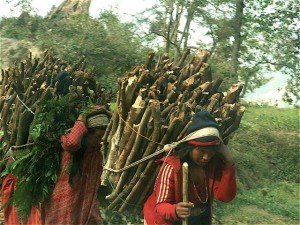
The World Wildlife Fund Nepal conducts trainings with HotPot

Nepalese women carrying firewood home
The World Wildlife Fund Nepal asked a representative of Solar Household Energy to travel to Nepal to train villagers and the staff of WWF Nepal how to use the 500+ HotPot solar ovens that were purchased with a grant from Alcoa Foundation. Since I was already in India for the months of December and January to attend two conferences, I volunteered to conduct the training for ten days between the conferences.
The purpose of the project was to provide villagers in Langtang National Part with a way to cook without chopping down more trees. I told the villagers that although one HotPot per family would not meet all their cooking requirements, they could still save fuel by using the device to cook parts of their meals with free sunshine. I also explained the concept of a retained heat cooker which would allow them to cook a pot of rice or dahl in the Hot Pot during the day, put it in the retained heat cooker and serve it piping hot in the evening. The women told me they use approximately 3 kilos of wood per day per person for cooking and heating water for tea. Although it is illegal to cut wood in national parks, this is what I saw everywhere.
The need for a massive campaign to promote ‘integrated solar cooking’ technology in Nepal is overwhelming. Rather than continuing to provide unsustainable subsidies to reduce the cost of cooking gas to the public, it would be far more sustainable if the Nepali and other governments were to offer subsidies for the purchase of solar cookers, retained heat cookers, biogas cookers and fuel-efficient stoves. On the last day of our training program, I filmed my Nepalese WWF colleague repeating in his language my instructions on how to use and care for the HotPot.



